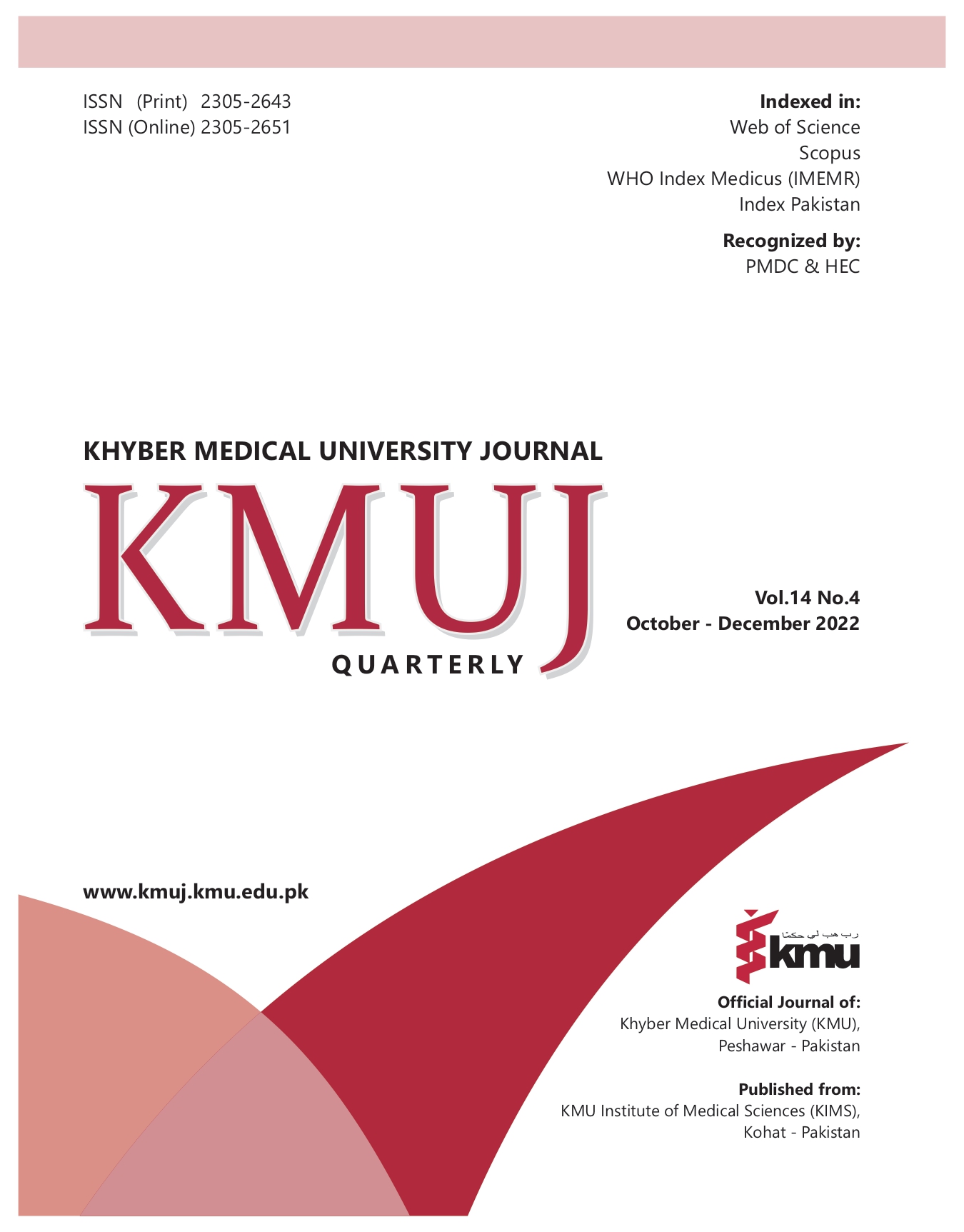CORRELATION BETWEEN MOLARS ANGULATION, OVERBITE AND VERTICAL SKELETAL PATTERN
Main Article Content
Abstract
OBJECTIVE: To determine the correlation between molars angulation, overbite and vertical skeletal pattern.
METHODS: This descriptive cross-sectional study was conducted from June to August 2019. Pretreatment records (lateral cephalograms and dental models) of 81 individuals were selected from the database of the Orthodontics Department. Overbite was measured from dental casts with a ruler and the values were recorded in both millimeter readings and percentages. Angulation of molars and the vertical skeletal pattern was evaluated from the lateral cephalograms. Correlation among molars angulation, overbite and vertical skeletal pattern was measured with the help of Pearson’s correlation.
RESULTS: Out of 81 patients, 39 (48.1%) were males and 42 (51.9%) were females. Mean age of patients was 17+3 years. Mean angular measurements for upper 2nd molar angulation, upper 1st molar angulation, lower 2nd molar angulation and lower 1st molar angulation were 79.77±7.324, 82.38±5.967, 86.94±6.837, 82.38±6.638 degrees respectively. Mean linear measurements for posterior facial height (PFH), lower anterior facial height (LAFH), Jaraback’s Ratio (PFH/AFH), lower anterior facial height percentage (LAFH/PFH) were 74.70±7.410, 62±6.4502, 66.63±5.769, 55.24±3.6272 and 3.414±2.1727 respectively. A positive, significant correlation was found between angulation of lower 2nd molars and overbite. Correlation between angulation of lower molars, PFH and Jaraback,s ratio was positive and significant. Similar relationship was also determined between upper molars and vertical skeletal pattern.
CONCLUSION: Angulation of upper and lower molars changed according to vertical skeletal pattern of an individual. Angulation of lower molars also changed with the overbite. Such a correlation was not found between upper molars and overbite.
Article Details
Work published in KMUJ is licensed under a
Creative Commons Attribution 4.0 License
Authors are permitted and encouraged to post their work online (e.g., in institutional repositories or on their website) prior to and during the submission process, as it can lead to productive exchanges, as well as earlier and greater citation of published work.
(e.g., in institutional repositories or on their website) prior to and during the submission process, as it can lead to productive exchanges, as well as earlier and greater citation of published work.
References
Andrews LF. The six keys to normal occlusion. Am J Orthod 1972;62(3):296-309. https://doi.org/10.1016/s0002-9416(72)90268-0
Vela E, Taylor RW, Campbell PM, Buschang PH. Differences in craniofacial and dental characteristics of adolescent Mexican Americans and European Americans. Am J Orthod Dentofacial Orthop 2011;140(6):839-47. https://doi.org/10.1016/j.ajodo.2011.04.026
Arat ZM, Rubenduz M. Changes in dentoalveolar and facial heights during early and late growth periods: a longitudinal study. Angle Orthod 2005;75(1):69-74. https://doi.org/10.1043/00033219(2005)075<0069:Cidafh>2.0.Co;2
Kim YE, Nanda RS, Sinha PK. Transition of molar relationships in different skeletal growth patterns. Am J Orthod Dentofacial Orthop 2002;121(3):280-90. https://doi.org/10.1067/mod.2002.119978
Bjork A, Skieller V. Facial development and tooth eruption. An implant study at the age of puberty. Am J Orthod 1972;62(4):339-83.
Su H, Han B, Li S, Na B, Ma W, Xu TM. Compensation trends of the angulation of first molars: retrospective study of 1403 malocclusion cases. Int J Oral Sci 2014;6(3):175-81. https://doi.org/10.1038/ijos.2014.15
Su H, Han B, Li S, Na B, Ma W, Xu TM. Factors predisposing to maxillary anchorage loss: a retrospective study of 1403 cases. PLoS One 2014;9(10):e109561. https://doi.org/10.1371/journal.pone.0109561
Lie F, Kuitert R, Zentner A. Post-treatment development of the curve of Spee. Eur J Orthod 2006;28(3):262-8. https://doi.org/10.1093/ejo/cji111
Aliaga-Del Castillo A, Janson G, Arriola-Guillen LE, Laranjeira V, Garib D. Effect of posterior space discrepancy and third molar angulation on anterior overbite. Am J Orthod Dentofacial Orthop 2018;154(4):477-86. https://doi.org/10.1016/j.ajodo.2017.12.014
Rijpstra C, Lisson JA. Etiology of anterior open bite: a review. J Orofac Orthop 2016;77(4):281-6. https://doi.org/10.1007/s00056-016-0029-1
Arriola-Guillen LE, Flores-Mir C. Molar heights and incisor inclinations in adults with Class II and Class III skeletal open-bite malocclusions. Am J Orthod Dentofacial Orthop 2014;145(3):325-32. https://doi.org/10.1016/j.ajodo.2013.12.001
Hasegawa Y, Terada K, Kageyama I, Tsuchimochi T, Ishikawa F, Nakahara S. Influence of third molar space on angulation and dental arch crowding. Odontology 2013;101(1):22-8. https://doi.org/10.1007/s10266-012-0065-2
Kim YH. Anterior openbite and its treatment with multiloop edgewise archwire. Angle Orthod 1987;57(4):290-321. https://doi.org/10.1043/0003-3219(1987)057<0290:Aoaitw>2.0.Co;2
Downs WB. Variations in facial relationships; their significance in treatment and prognosis. Am J Orthod 1948;34(10):812-40. https://doi.org/10.1016/0002-9416(48)90015-3
Janson G, Crepaldi MV, de Freitas KM, de Freitas MR, Janson W. Evaluation of anterior open-bite treatment with occlusal adjustment. Am J Orthod Dentofacial Orthop 2008;134(1):10-11. https://doi.org/10.1016/j.ajodo.2008.06.005
Arriola-Guillen LE, Aliaga-Del Castillo A, Flores-Mir C. Influence of maxillary posterior dentoalveolar discrepancy on angulation of maxillary molars in individuals with skeletal open bite. Prog Orthod 2016;17(1):34. https://doi.org/10.1016/j.ajodo.2008.06.005.10.1186/s40510-016-0147-8
Wise GE, Frazier-Bowers S, D’Souza RN. Medicine. Cellular, molecular, and genetic determinants of tooth eruption. Crit Rev Oral Biol Med 2002;13(4):323-35. https://doi.org/10.1177/154411130201300403
McNamara JA, Jr. A method of cephalometric evaluation. Am J Orthod 1984;86(6):449-69. https://doi.org/10.1016/s0002-9416(84)90352-x
